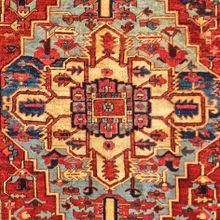Bakhshaish Rug
| Bakhshaish Rug | |
|---|---|
 Design of Bakhshaish Rug (Rugman) | |
| General information | |
| Name | Bakhshaish Rug |
| Original name | قالی بخشایش |
| Alternative name(s) | Bakhshaish Carpet |
| Origin | |
| Category | Village |
| Technical information | |
| Common designs | Lachak Toranj, Herati (Fish), Geometric |
| Common motifs & patterns | like to Heriz Rug |
| Common colors | Blue, Red, Beige, Camel |
| Dyeing method | Natural, synthetic |
| Pile material | Wool |
| Foundation material | Cotton, Wool |
| Knot type | Symmetrical (Turkish) |
Bakhshaish Rug originate from Bakhshaish, a small village in the Province of Azerbaijan, has an excellent reputation for traditional rug weaving. Located in northwestern Iran, the traditional rug weavers in Bakhshaish have been strongly influenced by their neighbors in Heriz. Although the patterns and styles are very similar to the rugs produced in Heriz, the distinguishing difference is that the color scheme on a Bakhshaish traditional rug features rich colors such as navy blue or red which are often highlighted with amazing color, while in Heriz the geometric medallion is set on a lighter colored field. Bakhshaish rugs are woven using coarse Turkish knots. This tight knotting process makes it extremely durable.
History
Bakshaish, also spelled Bakshayesh, is a town in the East Azerbaijan Province of northwestern Iran. In the nineteenth century it was a weaving village populated by the Azeri tribe who speak in a Turkic dialect. Bakshaish rugs and carpets are known in the market from the mid- nineteenth century.
Materials
Foundation and Pile
Many carpets have a cotton foundation and a wool pile, but in early pieces, Bakshaishes can have a wool foundation or a cotton ward with a wool weft.
Techniques and structures
Color and dyeing
Bakshaishes are famous for having a diverse range of colors for the background, especially lighter tone colorations such as beige, ivory, light greens, light blues, gold, and camel, along with rust-red and dark blues. This was a very important and positive change for Persian weavings in the nineteenth century. In addition to these colors, different shades of red, blue, green, cinnamon, gray, gold, and brown appear in the medallion, borders, and design elements. Dark brown or black is woven for the design outlines.